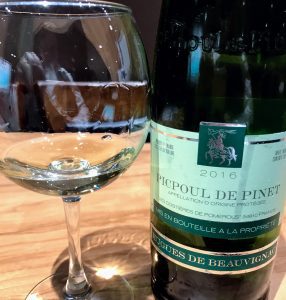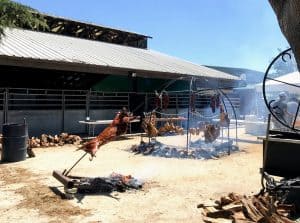
The BBQ prep for the closing dinner.
I just got back home from a wonderful weekend down in Paso Robles attending the 2018 Hospice du Rhône. This was my first time attending the event and I can tell you that my wife and I are already making plans to attend the 2020 event April 23rd-25th.
Heck, we are even thinking about attending the 2019 event in the Rhône Valley.
We purchased two weekend passes at $995 each which got us:
Four seminars featuring 9 to 11 wines–including many limited releases and small-lot productions.
Two lunches (a Rosé lunch on Day 1 and Live Auction lunch on Day 2)
Opening and Closing Grand Tastings featuring hundreds of wines with each day having a different theme (older vintages for Day 1 and newer vintages for Day 2).
Farewell dinner and BBQ
As you can probably garner from the first paragraph, my wife and I left the event feeling that the cost of the weekend pass was more than worth it for the experience we got. So I’ll share some of my favorite geeky moments, top wines and the two slight negatives that put a damper on an otherwise stellar event.
I’ll save my thoughts on the four seminars (South Africa’s Cinsault Renaissance, A 6th Generation Crusade in the Barossa Valley, Lost and Found: Old Vine Rhônes Across California, The Majesty of Guigal) for future posts because there was a lot of great stuff from each to unpack.
Top 3 Geek Moments
Meeting two Masters of Wine in Billo Naravane of Rasa Vineyards and Morgan Twain-Peterson of Bedrock Wine Co. I got a chance to talk to Billo about the possibilities of Walla Walla hosting a future Hospice du Rhone (would be incredibly exciting!). With Morgan, it was hard not to be charmed with his unabashed geekiness for old vine vineyards in California.

John Alban, Morgan Twain-Peterson and Tegan Passalacqua at the old vine seminar.
Which along those lines…
Having the light bulb flick on about the treasure of old vine field blends. Some of the most exciting wines at the event were old vine field blends featuring a hodgepodge of grapes like Mataro (Mourvedre), Syrah, Peloursin, Zinfandel, Petite Sirah, Trousseau noir, Grenache, Mondeuse, Alicante Bouchet and the like inter-planted and fermented together. In an industry dominated by monoculture and mono-varietal wines, the character of these field blends like Carlisle’s Two Acres and Bedrock’s Gibson Ranch are off the charts.
And no one is intentionally planting field blends right now.
This truly is a treasure of the past when farmers, rather than viticulturists, just kind of did their thing and let what would grow, grow. That kind of proposition is way too risky today. But that only heightens the importance of saving these old vineyards and supporting the wineries who source fruit from them.
As a Millennial, the character and stories behind field blend plantings are the perfect antidote to the mind-numbing boredom of the “same old, same old”. Millennials are changing the wine industry with their craving for new experiences and new things as well as authenticity–which an old vine field blend delivers in spades. It’s why I’m skeptical that Cabernet Sauvignon will continue its dominance and why I don’t think Merlot’s downturn is just because of a movie.
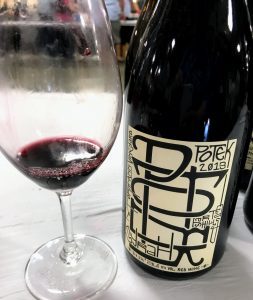
Potek Winery’s Mormann Vineyard Syrah from the Santa Rita Hills.
Great wine, but Potek’s labels are WAAAAAAY too busy. Admittedly, I wouldn’t even give them a second look in a wine shop because they’re so hard to read.
Though speaking of that movie…
Screw Pinot. Let’s start drinking Santa Barbara County Rhônes.
I mentioned this in my quick take on Day 1 and day 2 only reaffirmed how special these cool climate Rhônes are. I’ll also add the Russian River Valley of Sonoma to the list of “Must Seek Out” Syrah. Not only will you find Carlisle’s Two Acre gem here, but I was also thoroughly impressed with the RRV wines from MacLaren.
Top 10 (non-seminar) Wines of the Event
When you have wines like a 2005 Guigal La Turque poured at the seminars, it would be easy to fill up this list with nothing but seminar wines. But there were a lot of fantastic wines poured at the Opening and Closing tastings that are worth calling out.
So here are 10 of my favorites in no particular order.
2016 Jada Hell’s Kitchen Paso Robles — It was hard to narrow down just one of the Jada wines to put on this list because every single one of them was stellar. This one was very full-bodied and hedonistic with rich dark fruit, velvety smooth mouthfeel. A long finish with dark chocolate notes.
2016 Louis Cheze Condrieu Pagus Luminis — Crisp but mouthfilling. Lots of fresh tree fruit notes–apricots and peaches–with some stony minerality.
2016 CR Graybehl The Grenachista Alder Springs Grenache Mendocino County — I guess I could add this to my cool-climate Rhône discoveries. Like Jada, this was a hard one to narrow down because I loved everything from this producer. The Alder Springs had a particular vivacious mouthfeel of juicy blackberries with some spice and floral notes.
Note: I loved this wine so much that it was one of my top picks for International Grenache Day.
2012 Turtle Rock Willow’s Cuvee Paso Robles
Made by the assistant winemaker of Saxum. Truthfully, I liked these better than the Saxum wines I tried. Very floral with a mix of red and dark fruit. One of the best noses of the night.
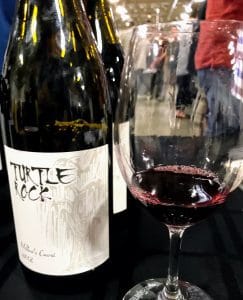
While I enjoyed the opportunity to try Saxum, I’m far more excited about the wines made by their assistant, Don Burns, with his wife Claudia at their Turtle Rock Winery.
2012 Dos Cabezas Wineworks El Campo Sonoita Arizona — One of the surprises of the event. A Tempranillo-Mourvedre blend from Arizona that tasted like a spicy Ribera del Duero and juicy Jumilla had a baby. Very impressive.
2008 Kunin Alisos Vineyard Syrah Santa Barbara County — Winners across the board from Kunin. A great mix of dark fruit and earthy forest floor. Very long finish. These were wines I wished I had more time to savor.
2012 Le Vieux Donjon Châteauneuf-du-Pape — This hit my perfect catnip style of savory, meaty undertones wrapped around a core of juicy, mouthwatering fruit. Such a treat to have. I suspect that 2015 will be even better with a few more years.
2007 Carlisle James Berry Syrah Paso Robles — All in all, Carlisle probably made my favorite wines of the entire event. I can still taste the 2016 Two Acres from the old vine seminar, but this James Berry was a close second. Still very lively with dark fruit, mouthwatering medium-plus acid. The finish brings some spicy minerality as well.
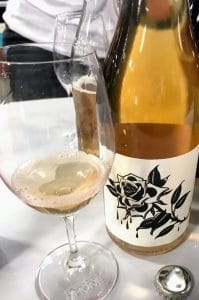
A 100% Cinsault pet-nat was not only geeky good but also a palate savior.
Would really love to see more sparkling wines like this at future Hospice du Rhone events.
2017 The Blacksmith The Bloodline Cinsault Pet-Nat Darling W.O. South Africa
This was much-needed salvation for the palate (see below), but it would have been a treat to try under any circumstance. Super geeky Cinsault pet-nat, this wine had a huge nose of orange blossoms and cherries that jumped out of the glass.
2005 Jean-Louis Chave Hermitage — This wine wasn’t part of any featured tasting and was certainly an unexpected treat that someone brought to the Live Auction lunch on Day 2. This was my first Chave and my lord! Still quite young and powerful for its age with layers of red fruit, savory Asian spices and a long finish of smokey BBQ notes.
Palate Fatigue and a little clicky culture
While overall, the event was fantastic, two things stuck out as minor negatives. One was the absence of sparkling wines, which are the guardian angels of the palate at tastings like these. As readers of my flashback review of the 2017 Taste Washington know, periodically taking a break from big, heavy reds with some palate-cleansing bubbles is a must if you’re going to maximize your tasting experience.
A few producers were pouring roses and crisp white wines, which helped. But it was disappointing not to see more sparkling examples. I know that the Rhône is not particularly well known for bubbles. However, there still notable regions like Clairette de Die and Saint-Péray AOCs producing sparkling wine. Australia also has a good tradition of making sparkling Shiraz. I’m sure there are examples, as well, from New World producers experimenting with sparkling Viognier and other varieties. It would’ve been great to give these wines more visibility.
The second negative was how “clique-y” the culture among the attendees was–especially at the lunches.
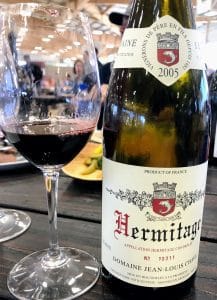
While some of the “clique-iness” at lunch was disheartening, the gracious couple who shared this wine from their table gave me an incredible thrill.
It’s wonderful that the Hospice du Rhône is in its 22nd year with many people attending this event regularly. But for a “newbie”, it felt hard at times to break into the crowd.
Again, this was most felt at the lunches. Several times seats and entire tables were reserved–not by official organizers–but, rather, other attendees who didn’t seem to have any interest in interacting with people that weren’t part of their local scene.
But there were undoubtedly more than enough gracious attendees who were welcoming and approachable. This includes the organizers themselves like John and Lorraine Alban, Vicki Carroll and Faith Wells. Along with the fabulous wines and seminars, this makes Hospice du Rhône well worth attending again.

 Going to need more than
Going to need more than 
